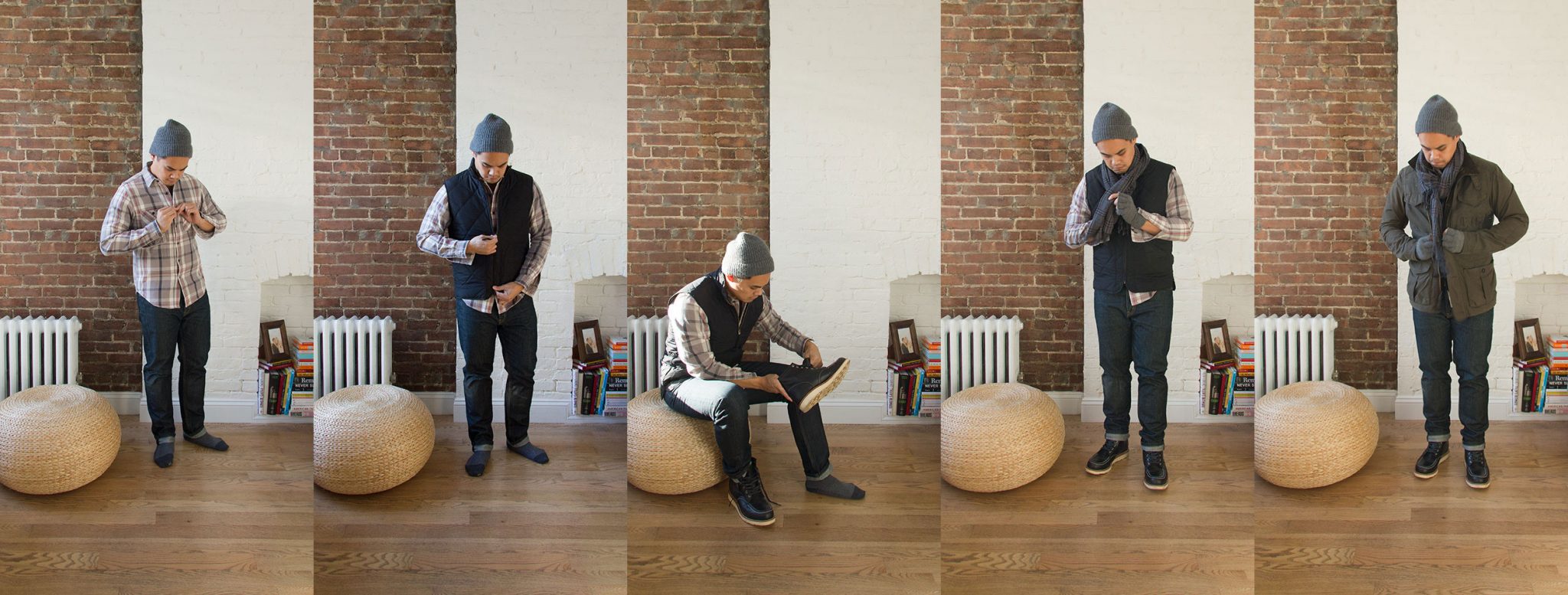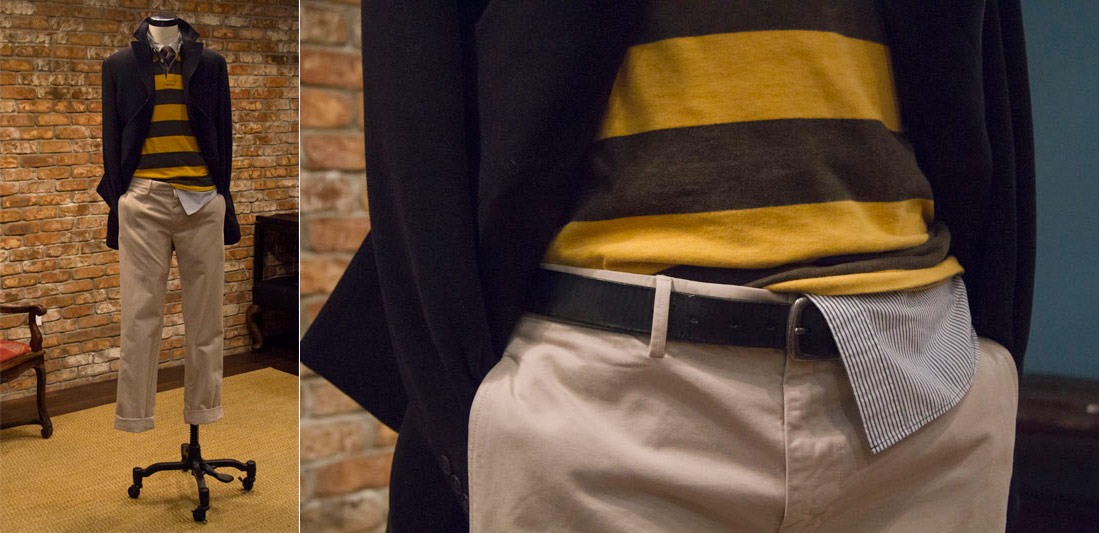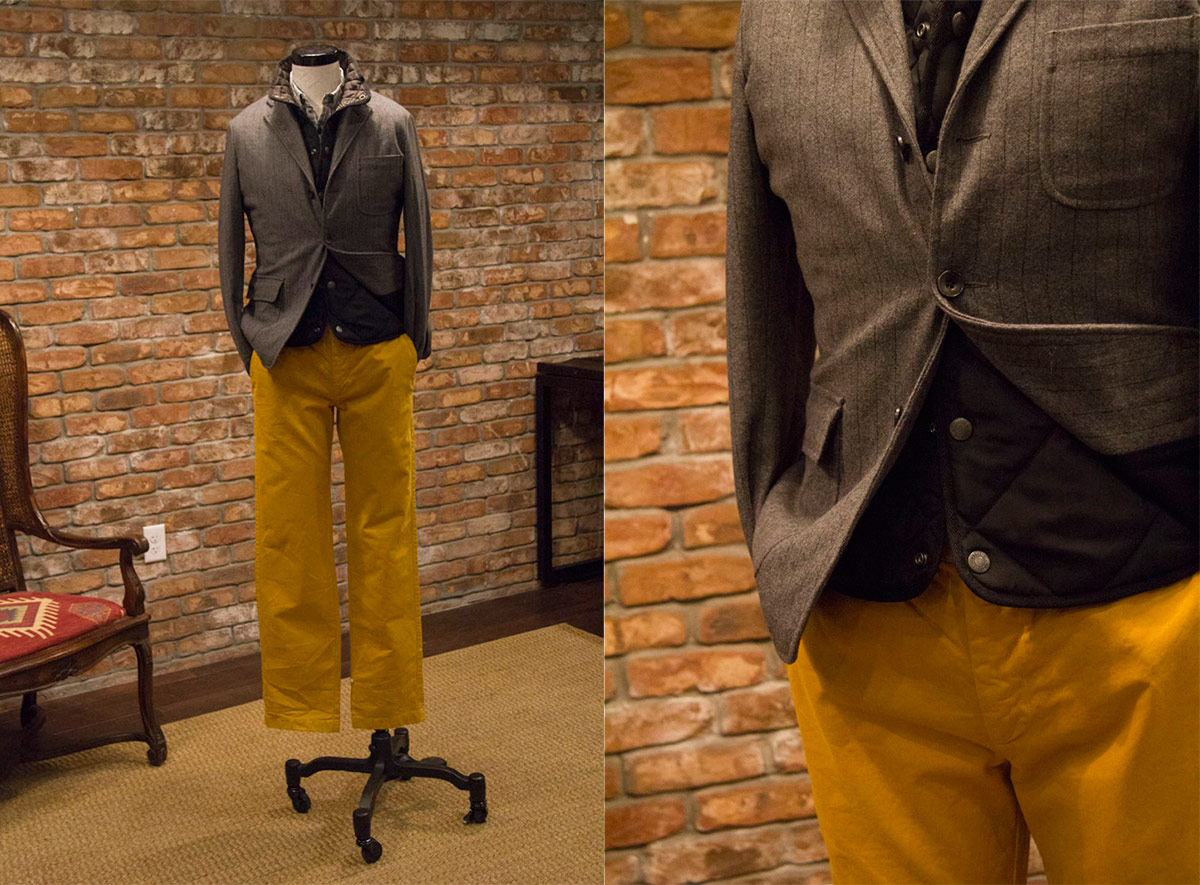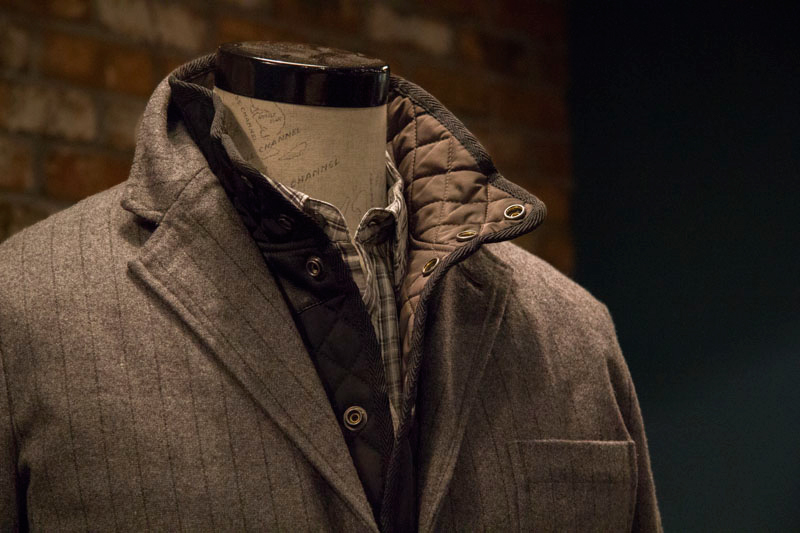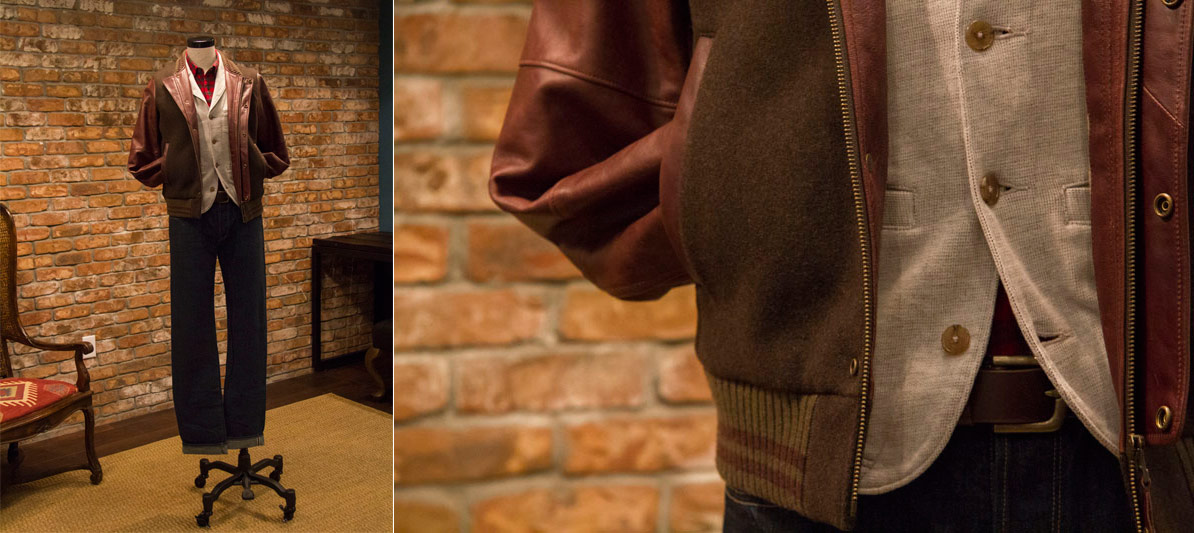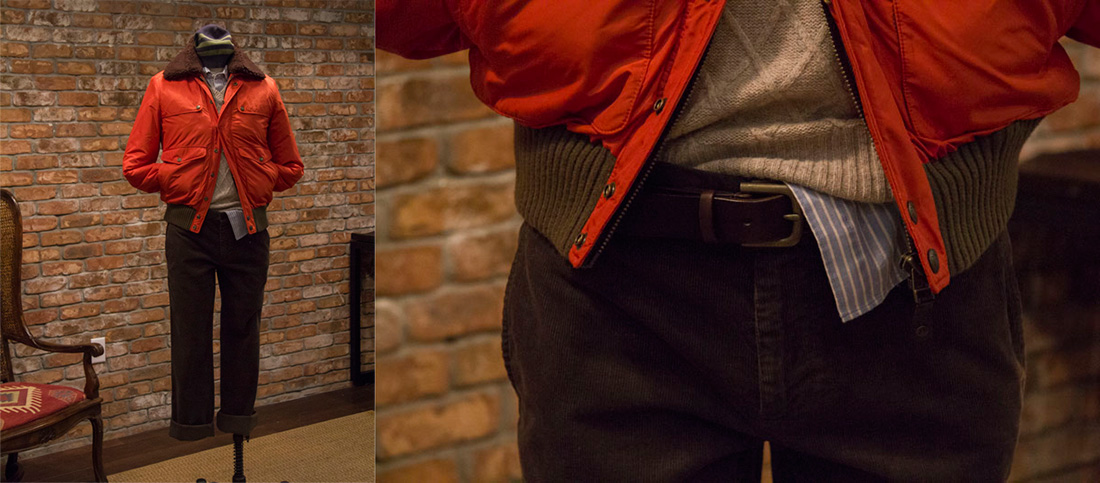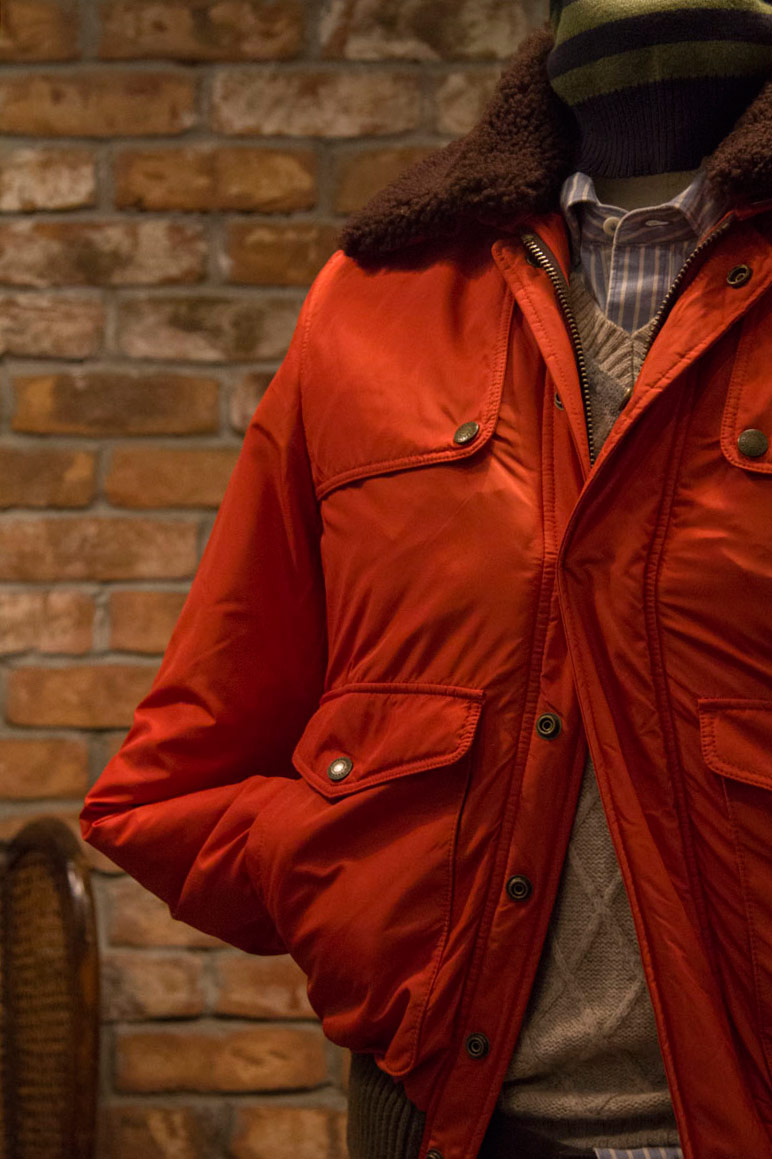When winter approaches and the temps start to dip, you’ll need to start layering up. And as the weeks roll on, it’ll only get colder, so if you don’t already know how to layer clothes the right way, it’s time to learn! We’ll be covering the details in this article.
Here’s the thing: You have to master the art of layering to a.) Stay warm and control your temperature effortlessly, and b.) Look awesome and well put-together!
Great layering requires great clothes to layer with. Let’s identify the different layering pieces, and we’ll put together some combinations so you’re not left out in the cold, so to speak, when it comes to doing it right.
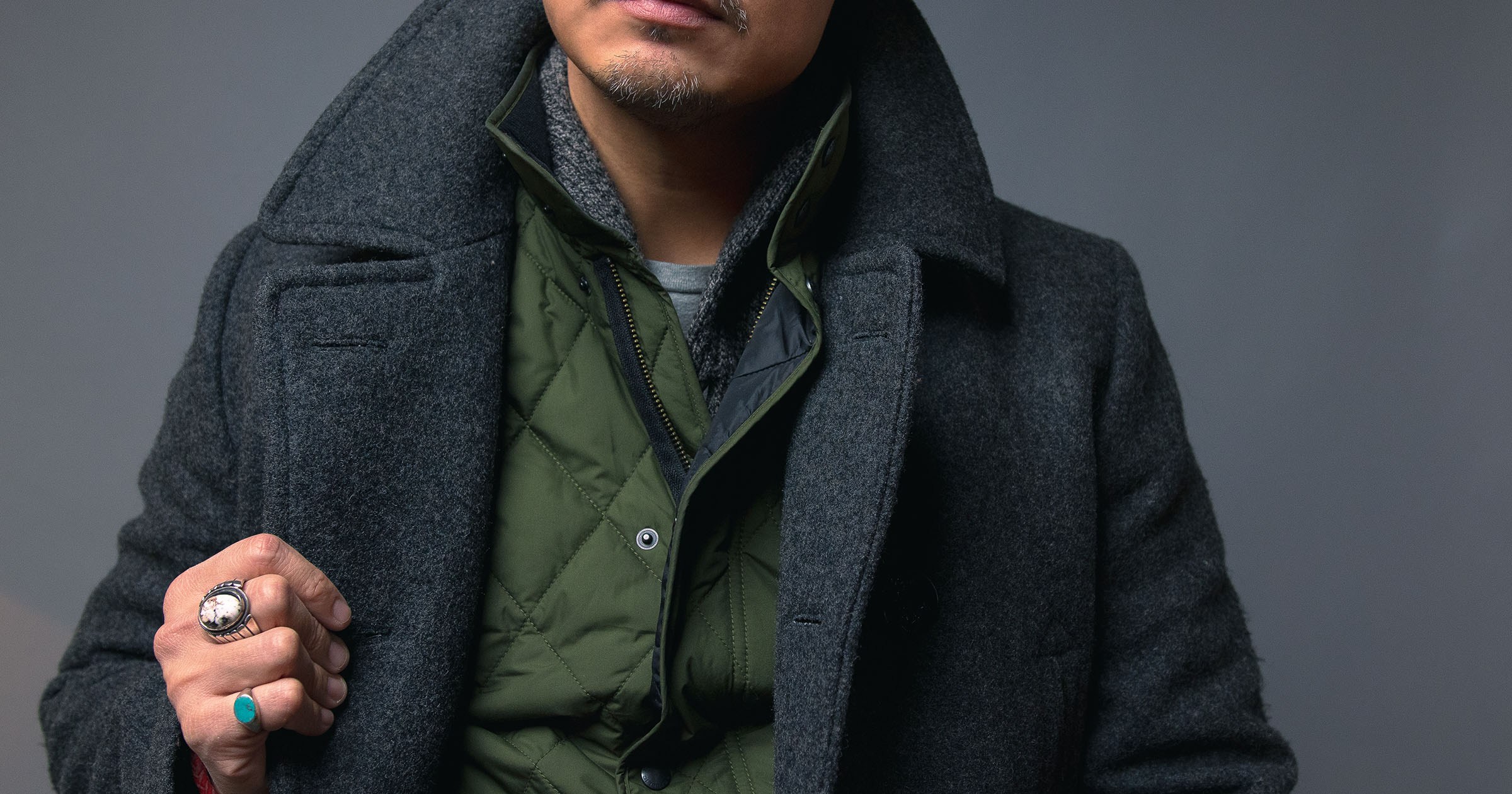
First Off, Why Layer At All?
Why not just throw on your heaviest coat over a T-shirt and call it a day?
I think one of the biggest mistakes guys make is to put on a single layer and a heavy coat, and that’s it. Here’s why:
- Effective layering makes it easy to maintain your desired temperature. It’s not easy to control your body temp when you only have a T-shirt and a heavy coat on.
- It’s a missed opportunity to put together an interesting outfit. When you have more items on your body, the more you get to experiment with looks as you combine different colors, patterns, and textures. Take a look at any menswear store’s window displays or dress forms during the fall or winter, and you’ll see some great examples.
- If you live in a place that isn’t freezing but still reaches colder temperatures, strategic layering will allow you to easily take off and put on layers as you move from indoors to outdoors, and vice versa.
What’s The Proper Way To Layer Clothes?
Layering is a lot simpler than it seems.
Technically, you could just throw on a bunch of stuff and be done with it, but you most likely want to look good and be comfortable.
The Golden Rule of Layering
Here it is: The closer a layer is to your skin, the thinner, lighter, and more fitted it should be.
Have you ever made the mistake of wearing a loose T-shirt? It can get a little uncomfy, resulting in a lot of tugging and adjusting. Not a good feeling.
The key is to keep those layers closest to the skin light, thin, and well-fitting, and work your way up to thicker, heavier fabrics as you get further away from the skin.
Keeping your base layers slim and light will ensure that everything else fits well as you start adding more on top, and will also prevent any unwanted (and uncomfortable) wrinkling and bunching.
After a while, you’ll know the right amount of layers to wear depending on the temperature outside. If you run hot, you probably won’t need as many layers, and vice versa if you become cold easily.
In general, I’d suggest wearing three layers max (not including an undershirt or a coat). Any more and it will seriously restrict your range of motion.
If you tend to get cold, or live in a really cold place, then you might want to consider long underwear (thermal long johns, thermal undershirts, etc.) and a down parka.
For workouts, I use these Nike compression leggings which keep you warm, and if the need arises this winter, I won’t hesitate to wear these under my denim. Uniqlo has a line of undershirts and leggings called HEATTECH that are worth your consideration.
How To Wear Pattern When Layering
In general, outfits are easier to put together when you only have one pattern or print (e.g. a red buffalo check shacket, or a green tartan plaid
You can wear multiple patterns, but stick to one main, standout piece if you’re not too sure what you’re doing and if you want to avoid having an outfit that’s too loud and distracting.
But, if you are adding other patterns, make sure they’re: A.) smaller in scale, B.) lower in contrast, and / or C.) both… in comparison to your main pattern.
You’ll see a real-life example below, where I have one grey plaid
How To Wear Textures When Layering
OK so this isn’t a “rule”, per se… but it’s something to keep in mind and in most cases, looks better (and feels more comfortable).
For textures, it’s a good idea to have the smoothest layers closest to your skin. Fabrics can get progressively more textured the further away they are from your skin.
example of texture usage in outfits
Cotton T-
Wool crewneck sweater → Heavy duty wool pea coat
You’ll notice in the examples below, you start out with a smooth (and thin) fabric, and then everything gets a bit more textured (and thicker) from there. That’s how you want to approach texture in a layered outfit.
Your Layering Colors Should Complement Each Other
Of course, you want every clothing item you wear to complement everything else in your outfit.
Several years ago, I put together this Pinterest board (also below) because I noticed the most stylish women I saw really know how to put together great layered outfits. Not only did the clothing go well together, but so did the colors, patterns, and textures.
This may seem daunting at first, but the easiest way to make sure every color in your outfit complements each other is to wear menswear neutrals. If you wear menswear neutrals, it’s much harder to “mess up” your outfit with the wrong colors.
How To Layer Clothes: A Video Explanation
Check out this vid. I go through my thought process of exactly how I layer my clothing and put together an outfit.
Didn’t know Effortless Gent had a YouTube channel? Tap here to subscribe.
How To Layer Clothes With These Can’t-Fail Combos
A quick and easy layering tip:
- Pick a base layer (in our example, either a henley or a twill
shirt ), - Pick a mid-layer (you have a large selection, from sweaters to down vests and even a denim jacket),
- And finally, pick a coat (peacoat or duffle, in this instance, although in real life you have plenty of options, from down coats to top coats).
Pretty straight-forward, right?
A Few Examples of Layering Pieces
Below are a few examples of “layerable” pieces. You can essentially pick a
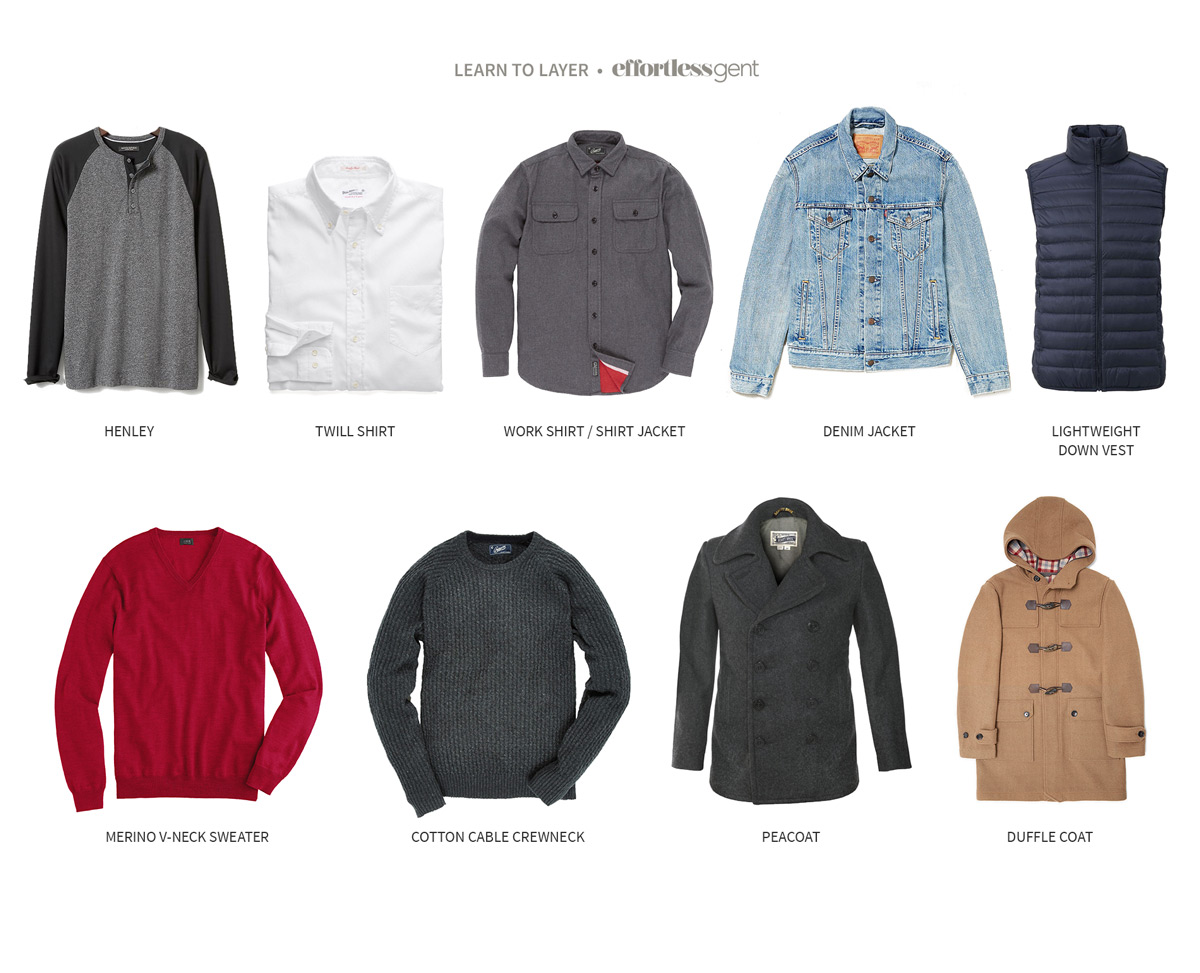
And of course some of these pieces can lean a bit more formal, others, a bit more casual. Let’s put together some examples of both so you get an idea.
A More Casual Layered Outfit
This set is decidedly more casual since you’re starting with a henley (which could also be substituted for a long sleeve tee or polo).
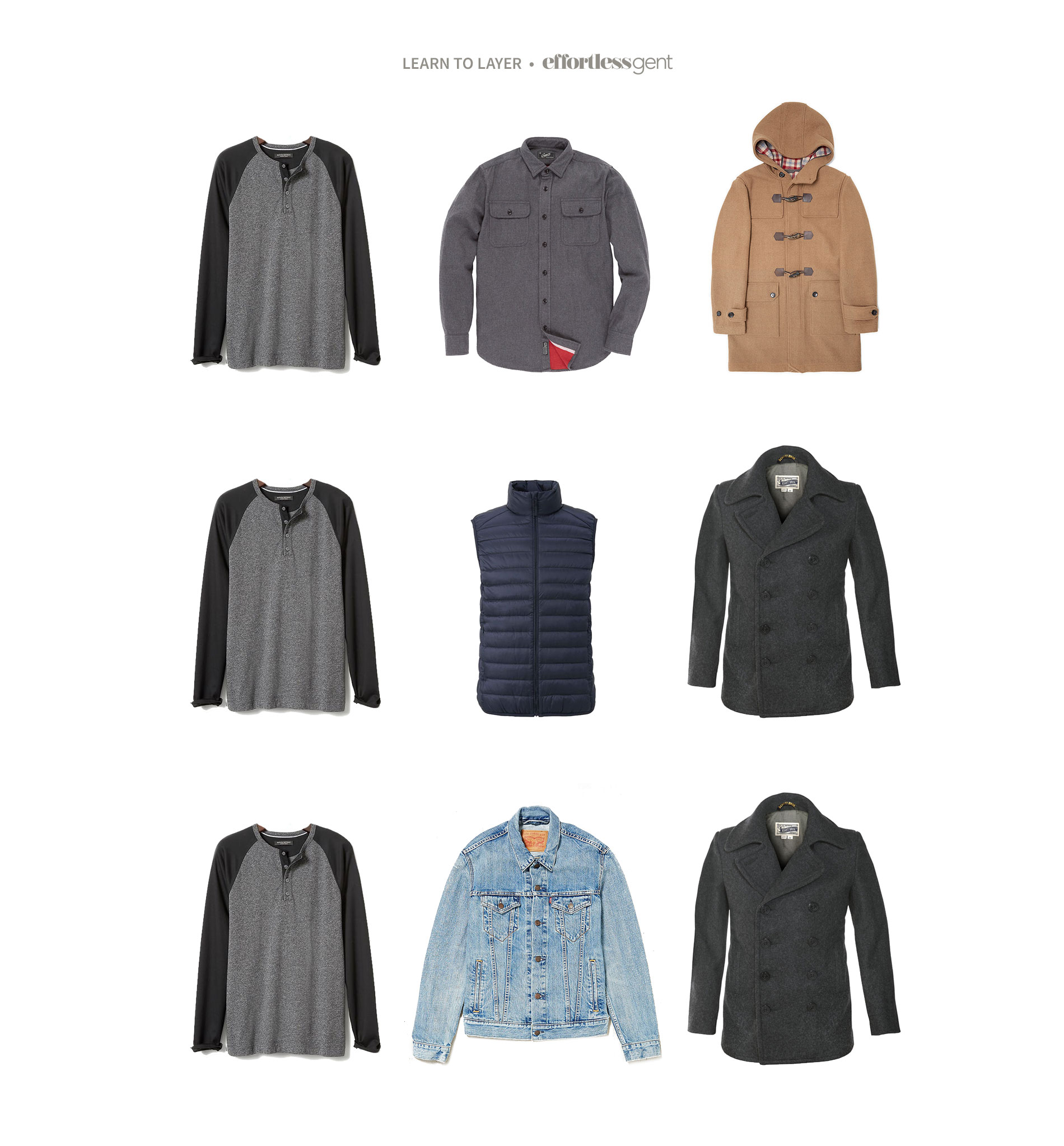
In the first row, you’re taking advantage of the heavier work
And in the third row, the denim jacket brings a spring staple into the winter season. You’re bound to stay warm, as long as you have a more substantial coat on top.
In reality, both the duffle and the peacoat would work with any of these combos. Don’t feel restricted to choosing one over the other.
A Smart Casual Layered Outfit
The second set of layers can go either way, in terms of formality. It all depends what you decide to wear down below.
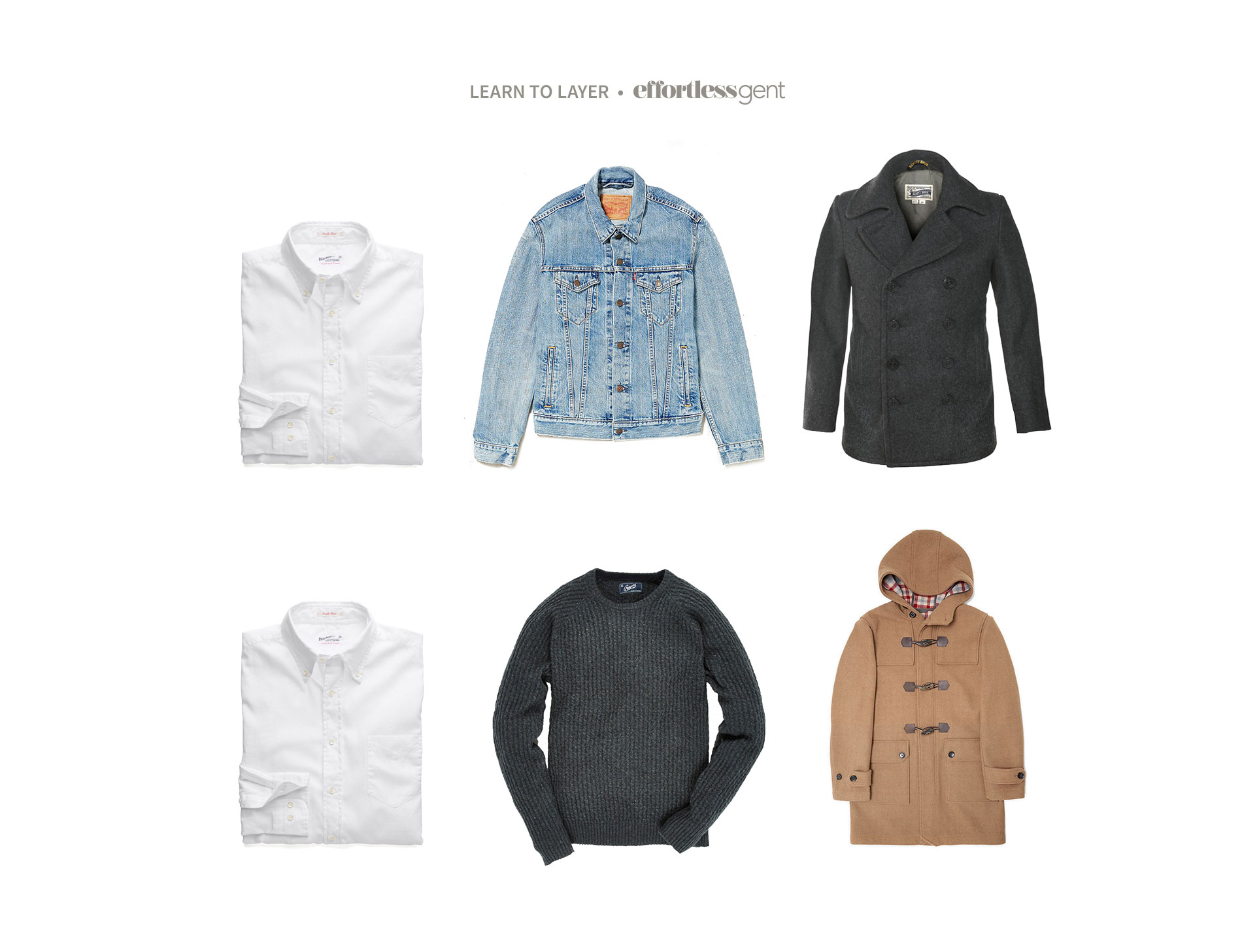
Go with mid-grey flannel trousers and rich, brown leather wingtips, and you have yourself a “smart casual” rig. On the other hand, throw on some chinos and sneakers, and you look more casual, yet still very put together.
The denim jacket plays nicely no matter the direction you’re trying to take the outfit, and if you are leaning more formal (with trousers and wingtips), it gives you a great high-low look, one that we champion a lot here on EG.
Example Using Two Different Midlayers
In this third set, we’re incorporating two different mid-layers. This may be overkill in some instances, but it can definitely work, so long as you have your fabric weights right.
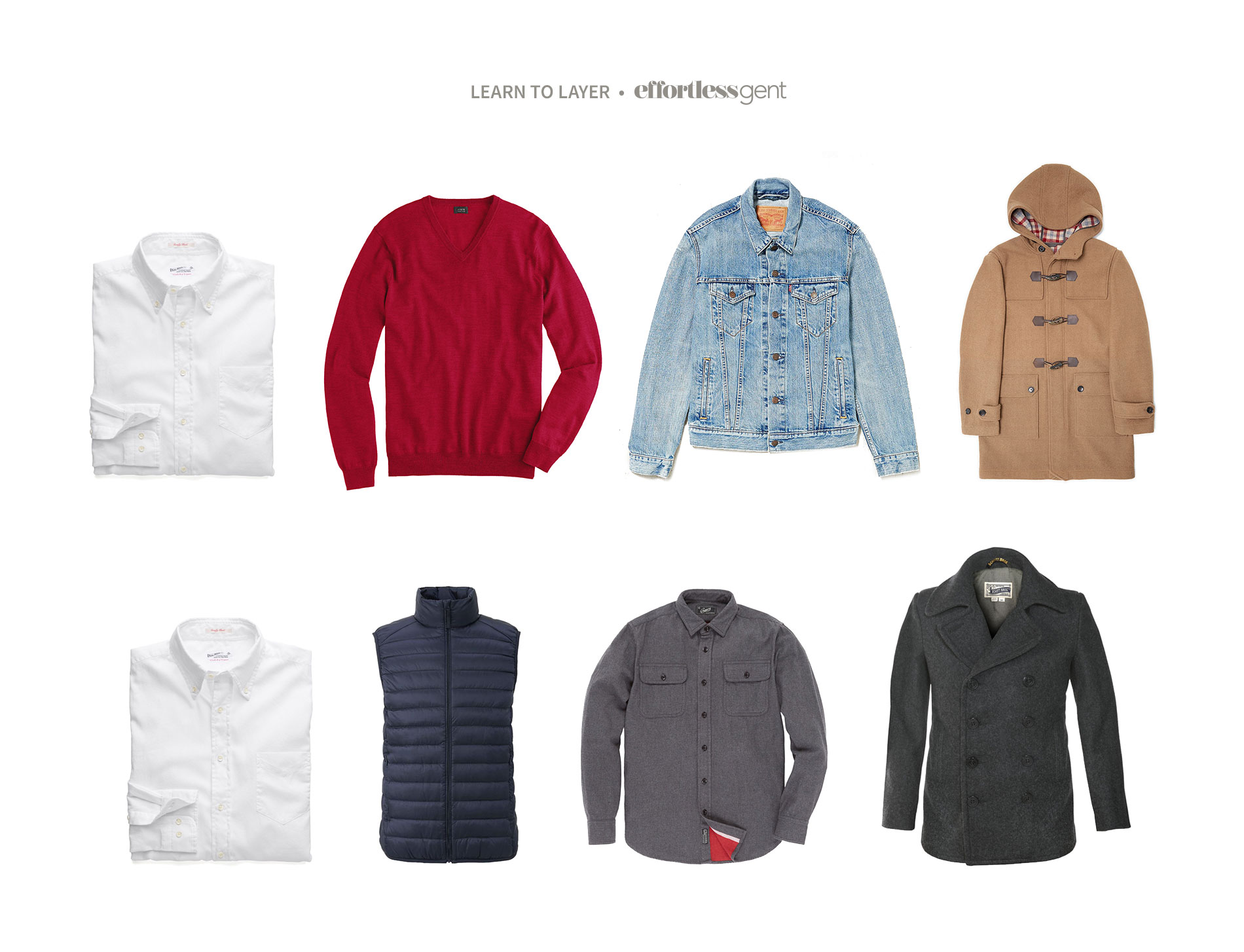
For example, the merino V-neck in the first row is thin enough to fit under the denim jacket. Same goes for the lightweight down vest in the second row. You can barely tell it’s on!
It fits under a work
A Real-Life Outfit Layering Example
Here are some clothes I grabbed from my closet.
This is pretty typical of what I’d wear on a casual day in late autumn / early winter when running errands, meeting up with friends, or just hanging out here in NYC.
Of course this outfit won’t keep you warm in the most frigid of temperatures, but I can easily get around in 40°F winter weather bundled up in this.
- Denim: Levi’s 541 Regular Taper Jeans
- Shirt: Cotton Twill (other styles)
- Vest: J.Crew Factory Walker Vest
- Coat: J.Crew Waxed Cotton M65 Field Jacket (similar)
- Boots: Chippewa 6″ Moc Toe Wedge
- Socks: Gray / Black Herringbone cotton socks (similar)
- Beanie: Gray cashmere (similar)
- Gloves: wool fingerless (similar)
- Scarf: charcoal plaid (similar)
Each Item Can Be Swapped Out
The photo above is just a sampling of what I picked from my closet that day.
You may not have these exact items, and even if you did, you may not be in the mood to wear them, or feel inclined to combine them in the way I did.
The good thing is, you can swap out lots of items for similar things in your wardrobe.
Easy Layering Swaps For Your Fall / Winter Outfit
quilted vest ↔ denim jacket ↔ sweater ↔ cardigan
leather boots ↔ bean boots ↔ lace-ups
beanie ↔ wool dad cap ↔ wool fedora
cotton gloves ↔ leather gloves ↔ fur-lined gloves
M-65 field jacket ↔ wool pea coat ↔ puffer coat ↔ parka
You can literally swap any of these items based on your preference.
- If sweaters are more your thing than quilted vests, go with that.
- Raining outside, and you don’t want to ruin your new
leather boots ? Swap them out for Bean Boots instead. - Prefer a more formal look? Go with a wool fedora over a beanie.
You get the idea.
Using Fabrics and Patterns When Layering Clothes
A few years ago I styled these outfits from a now-defunct menswear brand, Onassis (RIP), and took photos specifically to show how fabrics, patterns, and color can make a layered outfit really interesting.
1. Rugby Over a Striped Dress Shirt
Here’s an example of that high / low look, a mixture of casual and dressy elements in one outfit. This would be a great (slightly dressier) everyday look, or a nice outfit for a smart casual / business casual office.
Starting off with a basic light-colored chino and pencil stripe dress
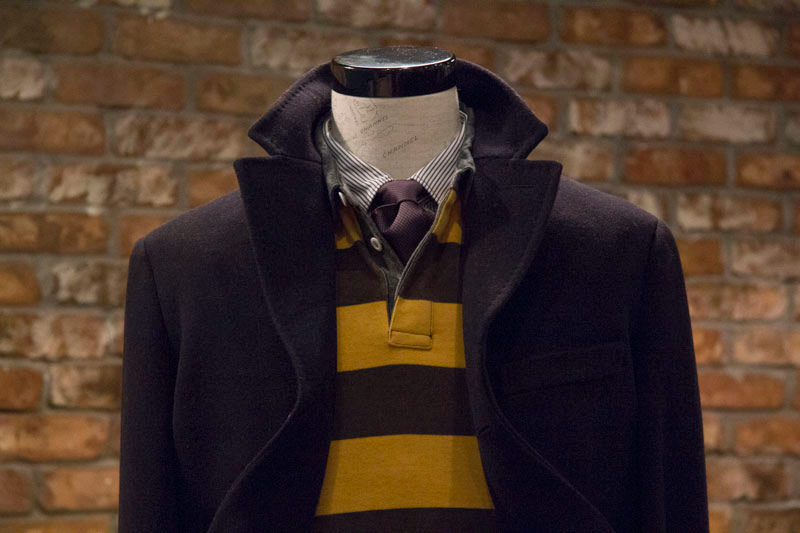
“Can you mix stripes like that?”
Yes, because the stripes are at such different scales. The bold stripe pattern of the rugby works well with the thin pencil stripe of the
2. Quilted Vest Under Sport Coat
Another take on the high / low outfit concept. What really dresses this up is the wool sport coat. Everything else is more casual. Good example of how one thing (in this case, a sport coat) can really elevate an outfit.
If you’re intimidated by wearing sport coats casually, I like to think of them like just another jacket in my closet, instead of part of a suit. Wearing
The quilted vest adds that additional layer of warmth (not to mention visual interest) which could potentially make you leave that coat at home. Of course, if it’s freezing outside, bring the coat anyway.
One Pop of Color (Optional) and Subtle Patterns
Notice the one bright pop of color, the mustard pants. Every other piece grounds that color by remaining neutral, muted. The nice thing is, even up close, you can see the shades of color that work well together.
When it comes to patterns, notice: Subtle stripe on the jacket, quilted pattern on the vest, muted, small scale plaid
3. Shawl Collar Under a Leather Jacket
This one is pretty straight-forward.
Throw on a v-neck under a flannel
Colors and Fabric Thickness For Layers
Again, notice there’s one bright pop of color (the red check flannel) but the rest of the outfit is pretty muted. If you’re ever worried about clashing colors, when you only have one vibrant color in an otherwise menswear neutral outfit, you’ll be fine.
And remember the Golden Rule of Layering here. In order to minimize bulk, you have to make sure each item is lighter, thinner, and more fitted the closer it is to your skin.
The sweater (or vest, in this case) should be loose enough for the flannel to fit comfortably underneath, but not so oversized that it bunches up in weird ways underneath your jacket.
4. Stripe Shirt , V-Neck Sweater, Flight Jacket
This example utilizes that pop of color well, but this time, it’s the outerwear.
Starting with a light blue striped
One Vibrant Color, Even With Outerwear
Hopefully you’re seeing the trend here.
If you ever want to include a nice punch of color in your outfit without going overboard, stick to one bright, vibrant item of clothing, and keep everything else in muted and earth tones.
Even the beanie, though it has color, isn’t too bright or attention grabbing.
Choosing Clothes With Contrast
I personally prefer outfits with contrast. I like the idea of tonal outfits (varying shades of one color), but I rarely do this.
You’ll see this outfit has good contrast between each piece. If you focus specifically on the cords and the sweater, you’ll notice that even though they both have brown tones, one is really dark like a cigar wrapper, and one is light like oatmeal. That’s contrast. Do more of that.
And then in the middle of it all, it’s broken up by that subtle injection of color from the blue and white stripes. Browns play really well with light blue. Keep that in mind.
Questions & Concerns About How To Layer Clothes Correctly
Even with all this info about how to layer clothes, you might still have some reservations. Are you doing it right? How many layers is too many? What if I still get hot / cold?
I asked EG readers on our Facebook page what their biggest hang-ups were when it came to layering clothing in the winter. I’ll answer the most common concerns here.
“I get really warm when I wear too many layers”
You know your body best. So if you’re feeling hot with your layers, don’t wear as many.
I’ve found that in the winter, the max amount of layers I would ever need, not including underwear / outerwear, is three (a button-up
Maybe you can do without a heavy coat if you’re wearing a sport
Maybe you walk to work, and even though you start off cold, you get warmer as you walk, so two layers under your coat works just fine.
If you tend to overheat easily, then wear one less layer. Or, perhaps all your layers need to be lighter, in terms of knit density, or fabric thickness.
There are a thousand different situations you could find yourself in, and like with everything new, it’s a guessing game until you’ve done it a few times. Figure out what works best for you through trial and error.
“How do I layer clothes without looking bulky or feeling uncomfortable?”
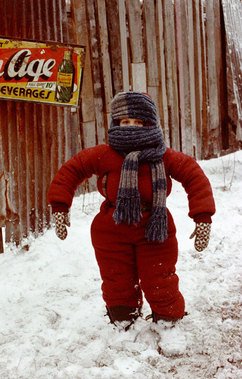
Are you wearing one too many layers?
If you feel restricted, maybe you have one too many layers on, or perhaps the particular combo you chose shouldn’t be layered together.
Or maybe you’re simply not used to it.
But if you follow the golden rule of layering (the closer a layer is to your skin, the thinner, lighter, and more fitted it should be) you’re able to avoid most of this discomfort. Double check your layers to make sure you’re following this rule.
Another thing that happens sometimes is, if you’re wearing a thick sweater with a slim coat, it can feel restrictive in the arms and chest.
That’s probably because your coat’s armholes are not big enough to accommodate your actual arms and a thick sweater. In that case, choose a different sweater, or a bigger coat.
You’ll get the hang of layering eventually! Keep trying.
“I live somewhere hot! How do I layer clothes without overheating?”
To be honest, wearing lots of layers may not make sense, depending on your location. If you live in a desert climate or a tropical country, for example, it probably doesn’t get cold often. Therefore, excessive layering isn’t necessary.
If you do live in a warm climate and you’re still interested in layering, then you’re probably doing so for style purposes, and to have a more interesting outfit. I get that.
The trick here is to wear lighter layers… lighter in weight, but also lighter in color.
Whenever I travel to warmer, more tropical climates, I always bring light and breathable garments—lightweight cotton, linen, tropical wool, etc.
You can wear a lightweight, unlined cotton sport coat over a linen button-up and not pass out from heat stroke. You wouldn’t want to wear a heavy wool flannel sport coat over a heavyweight twill button-up, obviously, because you’ll be too hot.
As far as colors, I stick with lighter ones simply because they absorb less heat during the day. But if the garment is already lightweight, like a navy linen button-up, I don’t worry about the fact that it’s dark. It’s already a loose and breathable garment.
So if you live or are traveling to somewhere warm, but you still want to layer your clothes, stick with lighter weight, and lighter colored, garments.
Does this help?
If you’ve ever been unsure about how to layer clothes the right way, I hope this extensive article has helped! At least now you know it can be done well, no matter where you live.
To be honest, you can’t really go wrong when layering.
Just remember: Keep your innermost layers thin and light, and work your way up in thickness and looseness from there, you will be 100% good to go.
I know layering can seem a bit weird at first, especially if you’re not sure which pieces can work together. But hopefully this article gives you a place to start!
What other layering questions (or tips!) do you have? Hit me up on Instagram DMs or Twitter.
Originally published February 7, 2013.


